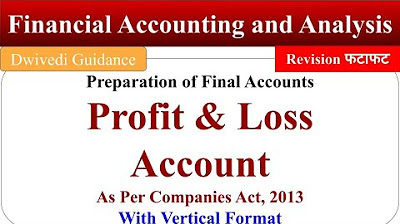Profit and Loss secrets explained
Summary
TLDRIn this video, Brad Flynn explains the importance of understanding financial statements for business success, focusing specifically on the Profit and Loss (P&L) statement. He compares it to a scorecard in sports, demonstrating how it helps track business performance. Flynn breaks down the five key components of a P&L: revenue, cost of goods sold, gross profit, fixed expenses, and net profit. He also highlights the significance of percentages and how to interpret them. Lastly, Flynn emphasizes the need for regular monitoring and adjustments to stay on track with business targets.
Takeaways
- 😀 The Profit and Loss (P&L) statement is like a scoreboard for your business, showing how well you're performing financially.
- 😀 The P&L statement includes five main components: Revenue, Cost of Goods Sold (COGS), Gross Profit, Fixed Expenses, and Net Profit.
- 😀 Revenue represents the total sales income your business generates from goods or services.
- 😀 Cost of Goods Sold (COGS) is the direct cost of producing the goods or services that your business sells, and it varies with sales.
- 😀 Gross Profit is the difference between revenue and COGS, showing how much money is left after direct costs are accounted for.
- 😀 Fixed Expenses are regular, recurring costs that don't change with sales, such as rent, wages, and insurance.
- 😀 Net Profit is the final amount left after subtracting fixed expenses from gross profit, representing your actual profit.
- 😀 Financial statements often use percentages to compare each component to total revenue, making it easier to see business performance.
- 😀 Regularly reviewing your P&L (ideally monthly) helps ensure your business stays on track to meet financial goals and targets.
- 😀 If you're not hitting targets, analyze the details in COGS and Fixed Expenses to identify areas for improvement.
- 😀 Different industries have varying profit structures; for example, service-based businesses may have higher gross profits due to low direct costs.
Q & A
What is the purpose of the profit and loss statement?
-The profit and loss statement, also known as the income statement, is used to evaluate a business's financial performance by showing revenue, expenses, and profits over a specific period.
How does a profit and loss statement differ from the balance sheet and cash flow statement?
-The profit and loss statement reflects past financial performance, showing revenue and expenses. The balance sheet focuses on the business's current financial position, while the cash flow statement projects future cash inflows and outflows.
What are the five key categories in a profit and loss statement?
-The five key categories are revenue (or income/sales), cost of goods sold (COGS), gross profit, fixed expenses, and net profit.
What is the significance of 'gross profit' in the profit and loss statement?
-Gross profit represents the remaining money after subtracting the cost of goods sold (COGS) from the total revenue, showing how much is left to cover other expenses.
What does 'cost of goods sold' (COGS) represent in the profit and loss statement?
-COGS refers to the direct costs associated with producing the goods or services that a business sells, such as materials or labor directly involved in production.
How are fixed expenses different from variable costs in a business?
-Fixed expenses are constant costs that do not change regardless of sales, such as rent, wages, and insurance. Variable costs, on the other hand, fluctuate based on production or sales volume.
How do you calculate net profit in the profit and loss statement?
-Net profit is calculated by subtracting fixed expenses from gross profit. It represents the final profit a business retains after all expenses.
What does a percentage breakdown in the profit and loss statement indicate?
-A percentage breakdown in a profit and loss statement shows how much each category (such as gross profit or fixed expenses) contributes relative to total sales, helping to identify areas of strength or concern.
Why is it important to compare a business's profit and loss statement to industry benchmarks?
-Comparing a business's performance to industry benchmarks helps identify whether the business is performing well relative to others in the same field and reveals areas for improvement.
What is the relationship between profit and loss statements and business strategy?
-The profit and loss statement helps businesses assess their financial health, adjust strategies, set targets, and make informed decisions to ensure profitability and growth.
Outlines

此内容仅限付费用户访问。 请升级后访问。
立即升级Mindmap

此内容仅限付费用户访问。 请升级后访问。
立即升级Keywords

此内容仅限付费用户访问。 请升级后访问。
立即升级Highlights

此内容仅限付费用户访问。 请升级后访问。
立即升级Transcripts

此内容仅限付费用户访问。 请升级后访问。
立即升级浏览更多相关视频

Aktivitas Belajar 7.4

Profit & Loss Account, Preparation of Final Accounts, Format of Profit and Loss Account, Accounting

KD 3 10 MENGANALISIS LAPORAN KEUANGAN SEDERHANA || PRODUK KREATIF DAN KEWIRAUSAHAAN

Accounting for IGCSE - Video 36 - Limited companies (Part 2) - Financial statments

Estado de resultados paso a paso en excel para principiantes ✅

7. The connection between balance sheet, P&L statement and cash flow statement
5.0 / 5 (0 votes)
